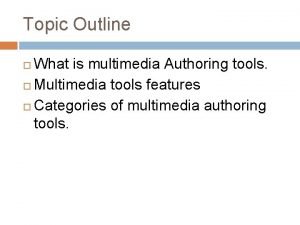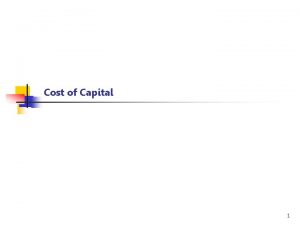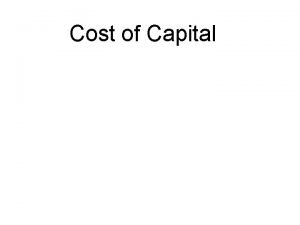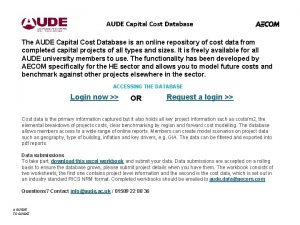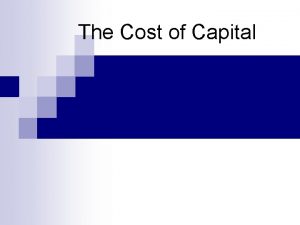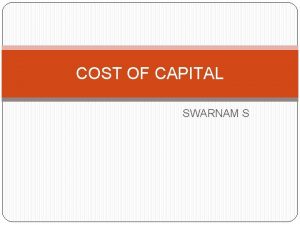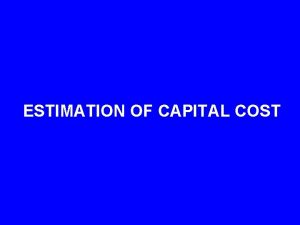Cost of Capital 1 Cost of Capital Perspectives









- Slides: 9

Cost of Capital 1

Cost of Capital Perspectives 2

WACC Formula (Wd) x (kd) + (Wp) x (kp) + (Wc) x (kc) Wd – Weight of long-term debt Wp – Weight of preferred shares Wc – Weight of common shares kd – Cost of long-term debt kp – Cost of preferred shares kc – Cost of common shares 3

WACC q WACC is the weighted average cost of permanent debt and equity financing only q Special applications include: q WMCC for projects in new industries q Divisional costs of capital q Private companies q Cost of capital components can be estimated using data from a pure play q Pure play is one or a group of comparable companies whose k d, kp, and kc approximate the risk level of the proposed project or division q Pure plays are difficult to find and their capital structures may not be similar, but their betas can be adjusted to reflect varying borrowing levels q Cost of capital should be adjusted for project risk Project Risk Category Project Types Adjustment WACC High New product expansions +2% 10% Moderate Cost savings projects Existing product expansions -0% 8% Low Equipment replacement -2% 6% Mandatory Environmental or safety equipment Not applicable 4

WACC - Weights q Weighting methods include: Book value Market value Target capital structure q Book values are easy to obtain but they are outdated q Market values are current but they fluctuate considerably and are not available for private companies q Stocks and bonds are issued in large amounts due to economies of scale so debt and equity weights can vary in the short term q Target capital structure is preferred because it is forward looking, stable, and does not require a share price q Not all companies know their target capital structure so market value is the next best choice, followed by book value if market values are not available 5

Cost of Common Shares CAPM kc = kf + Ba (km – kf) Implied kc kc = (D 1 / P 0) + g Treasury spread kc = kf + Spread. T Adjusting beta for financial leverage BL = BU (1 + (1 – t)(D/E)) q Cost of other equity securities such as stock options, warrants, rights, and conversion features should also be included in WACC but they normally make up a small part of total equity 6

Cost of Preferred Shares Implied kp kp = D 1 / P 0 q CAPM is not used to calculate kp because preferred shares have fixed payments like bonds so their betas are close to zero q If the price of a preferred share cannot be determined, k p may be estimated using the preferred shares of other companies with the same credit rating q A synthetic credit rating can be estimated by a credit rating agency if the company has not undergone a formal credit evaluation q Credit rating agencies have separate rating scales for long-term bonds, short-term debt securities, and preferred shares 7

Cost of Long-term Debt Implied kd P 0 = (I) (1 – (1 + kd)-n) / kd) + Principal / (1 + kd)n kd after tax = (kd) (1 – t) Treasury Spread kd = k. T + Spread. T kd after tax = (kd) (1 -t) q Cost of debt can be estimated using bonds with similar credit ratings, terms to maturity, collateral, subordination, and guarantees if a bond price is not available q A synthetic credit rating can be estimated by a credit rating agency if the company has not undergone a formal credit evaluation q Commercial loans and leases do not trade publicly so recently negotiated lending agreements with the same maturity and similar features are used to approximate the cost of debt q Companies will likely have more than one source of debt financing, so they should determine a weighted-average cost of debt using the current market rate and market value of each issue 8

Incorporating Issuance Costs Increase the Cost of Capital Retained earnings New common shares New preferred shares New long-term debt after tax kc = (D 1 / P 0) + gd kc = D 1 / (P 0 – f) + gd kp = D 1 / (P 0 – f) (kd) (1 – t) / (1 – f) Include as a Negative Initial Cash Flow q After-tax issuance costs are included as a negative initial cash flow in the capital budgeting process Preferred Approach q First method is least preferred as this spreads the issuance costs out over the life of the project instead of recognizing them all at the beginning when incurred 9
 Multinational capital structure
Multinational capital structure Multinational cost of capital and capital structure
Multinational cost of capital and capital structure Four perspectives of curriculum
Four perspectives of curriculum Perspective and methodology of economics
Perspective and methodology of economics Four main perspectives in multimedia authoring tools
Four main perspectives in multimedia authoring tools Four theoretical perspectives
Four theoretical perspectives Law perspectives ebooks
Law perspectives ebooks Historical perspective of midwifery
Historical perspective of midwifery Family matters definition
Family matters definition Leadership perspectives
Leadership perspectives




